Results 321 to 330 of 12094
Thread: Anandtech News
-
02-14-11, 08:50 AM #321
Anandtech: HP's TouchPad at MWC 2011
HP stopped by a Qualcomm roundtable discussion to demonstrate the HP Veer, Pre 3 and TouchPad that it recently announced. Mithun covered the webOS event for us but this was the first time I was able play with the devices.
Everything HP announced at its event is powered by a Qualcomm SoC. The Veer runs webOS 2.2 and uses a MSM7230 with a single Scorpion core running at 800MHz. The primary take away from my experience with the Veer is that it is really, really tiny.
The Pre 3 felt very good and snappy. It's based on the highest clocked single-core ARM based SoC on the market today: Qualcomm's MSM8x55 running at 1.4GHz. Qualcomm mentioned that this is a standard part that's available to everyone - why HP ended up being the first to launch with it is unusual.
One thing I did notice in using all of the devices is that there's still room for performance optimization. There are occasional slowdowns or dropped frames in the UI. The HP representative present indicated that there's still a great deal of work to be done on both the hardware and software side before the devices ship.
The TouchPad is by far the most interesting as webOS just begs to be used on a larger screen. The UI is smooth although again I saw some indications that HP needs to do more performance tuning. Given what we saw with the original Pre, I am concerned but we'll have to reserve judgement until final hardware hits the market. Performance optimizing can take a long time and we're still months away from a launch.
Check out the video above for a quick look at the HP TouchPad.
More...
-
02-14-11, 09:10 AM #322
Anandtech: Qualcomm Demos Remote Handwriting Recognition Using an Ultrasonic Pen
We've been talking about higher performance SoCs for quite a while now, but the number of applications for these things beyond making your UI faster is fairly limited today. With faster hardware comes more demanding software, and earlier today I got a glimpse of a pretty neat application that Qualcomm is looking at.
The technology comes from a company called epos. The device is a pen with two ultrasonic transmitters in it. You can write with the pen on any surface (e.g. a piece of paper) and use the microphone in your smartphone to pick up the sound signature emitted by the pen.
Pair it all up with some processing on Qualcomm's dual-core SoC and you can write on a piece of paper and have it automatically transcribe on your smartphone.
There are no changes that need to be made to the smartphone, you can rely on the standard microphone that ships on all smartphones. Epos mentioned that its software can pick up the pen's signature from a radius of around 30 cm from the mic.
The technology is pretty cool and I can see a number of real world applications for it. If you wanted a pen-and-paper feel but want your notes to be stored digitally, this is one option. Qualcomm mentioned that we could see smartphones or tablets featuring this technology starting next year.
More...
-
02-14-11, 10:00 AM #323
Anandtech: Microsoft Announces a Host of Windows Phone 7 Updates
At MWC 2011, Microsoft just announced a number of improvements for WP7 including the timeline for when its first update will be pushed to devices.
The update with app-loading performance improvements and copy paste support we demoed back at CES finally got a more specific release date - it's slated to launch in early March. A number of other updates are slated for 2011, though Microsoft wouldn't assign a specific date. Those updates include multitasking support for 3rd party applications, better cloud synchronization, more web-services built into hubs, and a completely new web browser.

Microsoft recognizes that the browser is probably the single most important mobile application. It needs to be speedy, needs to be usable, and needs to have full feature parity with desktop browsers. Though the WP7 browser feels very fast translating and zooming around, JavaScript was slow and HTML5 support was nonexistent. It was based on the older Trident engine used in pre-IE9 browsers, and never felt like it really belonged in the Web 2.0 or HTML5 era. Coming in 2011, WP7 will get a major update with an IE9 browser complete with the same level of GPU acceleration and HTML5 compatibility of its desktop brother. WP7's mobile IE9 browser will use the same core rendering engine as IE9's.
Mobile IE9 includes HTML5 support for the video tag as well. That's the same H.264 support as IE9 has on the desktop.
Next, WP7 will better leverage Microsoft's cloud assets, including SkyDrive support in the office hub. Other hubs are getting updates that include faster cloud sync. One of the major curiosities when WP7 launched was the absence of twitter support. Also part of 2011 will be an update that brings twitter integration in the people hub.
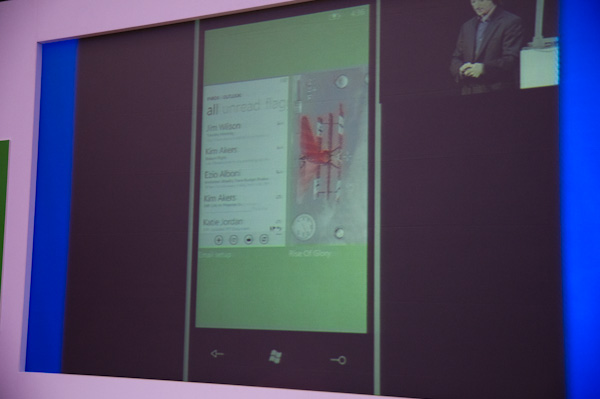
Probably the most major update, however will be inclusion of 3rd party multitasking support. Fast application re-hydration and a task manager menu are the key changes. The new multitasking interface allows for task switching using the back button. Pressing and holding the back button brings up a ring-switcher interface with screenshots of running applications.
Finally, Microsoft demonstrated an impressive example of cross WP7 and Xbox connectivity with a demo of users controlling the placement of obstacles in Kinect Adventures. Microsoft needs to move quickly to deliver WP7 updates into the hands of existing users to keep the platform competitive as Android and iOS also roll out updates.
More...
-
02-14-11, 12:00 PM #324
Anandtech: Samsung's Galaxy S II Preliminary Performance: Mali-400MP Benchmarked
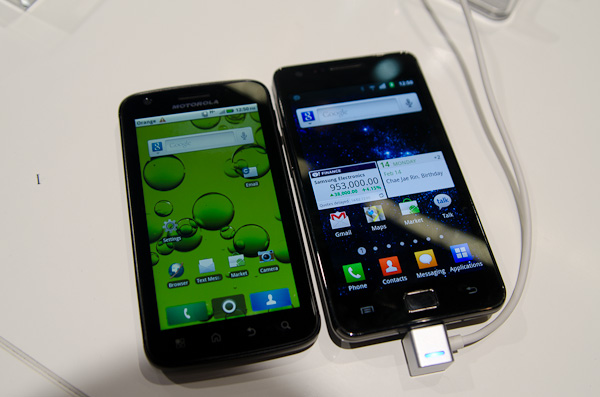
There's a lot of speculation about the SoC used in Samsung's Galaxy S II, thankfully through process of elimination and some snooping around we've been able to figure it out - and run some preliminary performance tests.
Read on to see how it stacks up against the latest NVIDIA Tegra 2 based smartphones.
More...
-
02-14-11, 12:50 PM #325
Anandtech: Sony Ericsson Announces Xperia Play, Neo, and Pro
Sony Ericsson’s big news from Barcelona is obviously the Xperia Play, the mysterious and oft-rumoured PSP-phone. But they’ve also announced two new additions to the Xperia line - the Pro and the Neo. Between today’s new phones and the Xperia Arc from CES, SE has a complete stable of new devices to take on the rest of the smartphone world.
Read on for more details.
More...
-
02-14-11, 06:40 PM #326
Anandtech: LG Announces 4-Pronged Mobile Strategy for 2011
On the first day of MWC 2011, LG announced its four-part smartphone and tablet strategy for 2011 as part of what it's calling a "new beginning" for becoming a key contender in the mobile space.

The strategy is simple and four-pronged. The first is dual-core and multi-core processing for performance. We've already taken a look at the LG Optimus 2X, the first dual-core phone, and found that it brought Android an appreciable speed increase. The software on the Optimus 2X is getting more stable - we're told the instability we saw in our review unit is totally fixed in newer builds, which we're having flashed.
The second part is display innovation, which no doubt is a reference to the LG Optimus Black and its super-bright NOVA display, or the inclusion of 3D stereoscopic displays on other LG smartphones. We got to look at the NOVA briefly at CES and were impressed with how bright and contrasty the display is, and we'll look at it in due time. Hopefully NOVA displays will move into more displays beyond just the Black.
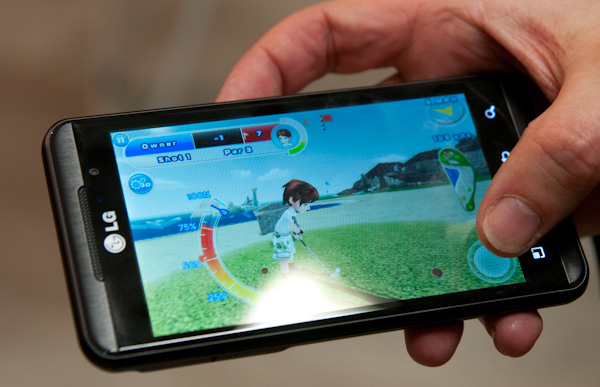
The third arm is 3D - which brings us to the LG Optimus 3D. As we already mentioned, the LG Optimus 3D is OMAP4 based with an OMAP4 4430 and features a glasses-free autostereoscopic 3D display and stereoscopic camera. The 3D camera system consists of two rear-facing 4 MP cameras spaced 24 mm apart. Recording in 3D also includes a live 3D preview with real-time adjustible depth control. We got a few minutes to look at the Optimus 3D and came away decently impressed with the glasses-free 3D screen. You can't see it above, but that golf game is entirely 3D on the Optimus 3D.
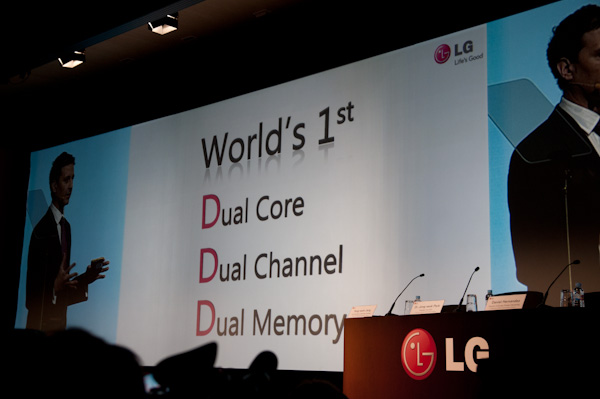
LG is aggressively marketing fact that the Optimus 3D is both dual-core and dual-channel. By dual-channel, LG is referencing OMAP4's dual-channel LPDDR2 memory interface. The Optimus 3D is listed as having 4 Gigabits of RAM translating to 512 MB. LG showed off the overall quadrant score of the 3D, and though we're not completely sold on Quadrant being a competent benchmark that truly reflects performance, the 2958 score is impressive next to 2670 which we saw on the Optimus 2X. The Optimus 3D captures 3D at 720P and 2D in 1080P. We look forward to benchmarking OMAP4 in due time.
Physical Comparison Samsung Galaxy S Fascinate LG Optimus 2X Motorola Atrix 4G Samsung Galaxy S II LG Optimus 3D Height 106.17 mm (4.18") 123.9 mm (4.87") 117.8mm 125.3mm 128.8 mm Width 63.5 mm (2.5") 63.2 mm (2.48") 63.5mm 66.1mm 68 mm Depth 9.91 mm (0.39") 10.9 mm (0.43") 10.95mm 8.48mm 11.9 mm Weight 127 grams (4.5 oz) 139.0 grams (4.90 oz) 135.0 grams 116 grams 168 grams CPU 1 GHz Samsung Hummingbird NVIDIA Tegra 2 Dual-Core Cortex-A9 (AP20H) @ 1 GHz NVIDIA Tegra 2 Dual-Core Cortex-A9 (AP20H) @ 1 GHz Samsung Exynos 4210 Dual-Core Cortex A9 @ 1GHz TI OMAP 4430 Dual-Core A9 @ 1 GHz GPU PowerVR SGX 540 ULV GeForce @ 100-300 MHz ULV GeForce @ 100-300 MHz ARM Mali-400 MP PowerVR SGX 540 RAM 512 MB LPDDR1 512 MB LPDDR2 @ 600 MHz data rate 1024 MB LPDDR2 @ 600 MHz data rate 1GB 512 MB LPDDR2 - Dual-Channel NAND 2 GB, 16 GB microSD (Class 2) 8 GB integrated (5.51 GB internal SD, 1.12 phone storage), up to 32 microSD 16 GB integrated, up to 32 microSD 16 GB integrated, up to 32 microSD 8 GB integrated, up to 32 microSD Camera 5 MP with auto focus and LED flash 8 MP with autofocus, LED flash, 1080p24 video recording, 1.3 MP front facing 5 MP with autofocus, LED flash, 720p video recording, VGA MP front facing 8 MP with autofocus, LED flash, 1080p video recording, 2MP front facing Dual 5 MP autofocus stereoscopic - 720P 3D capture, 1080P 2D Screen 4" Super AMOLED 800 x 480 4" IPS LCD 800 x 480 4" PenTile LCD 960 x 540
4.3" Super AMOLED Plus 800x480
4.3" Autostereoscopic 3D LCD 800x480
LG has secured a strategic partnership with YouTube to enable the Optimus 3D to both upload and locally play 3D content. YouTube feels that the Optimus 3D provides a leading 3D experience by enabling record and playback, and and in this way will catalyze 3D adoption.
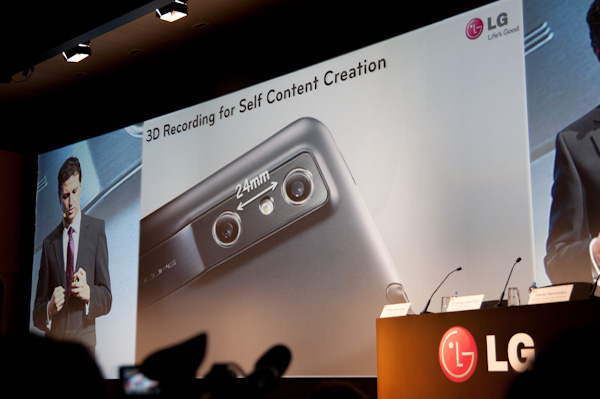
The Optimus 3D also has a dedicated 3D interface, including some preloaded 3D games from gameloft. It looks like NOVA (as in the game, not the display - how's that for a namespace collision) will be an included HD 3D title.
The fourth part of LG's strategy is getting into the "true tablet war" with the Optimus Pad.
LG wants the Optimus Pad to be an optimal balance between portability and productivity with an 8.9" size, and thinks it has the form factor right. The size is indeed an interesting balance between the 7" and 10" form factors we've seen thus far. LG made numerous illustrative comparisons with the Galaxy Tab and iPad.
The Optimus Pad is NVIDIA Tegra 2 powered, running Android 3.0 Honeycomb, and also incorporates a 3D camera system consisting of two 5 MP cameras. There's a host of preview modes, including mixed, anaglyph, and side-by-side viewing. There's also HDMI 1.4 output to playback that 3D on appropriate displays. The Optimus Pad also brings a 2 MP front facing camera (which seems to be the new standard) for HD video conferencing. We got some time with the Optimus Pad and plan to publish our impressions of the tablets we've seen so far in the next few days of MWC.
{gallery 950}
The Optimus Pad will be available in April, the Optimus 3D in May.
More...
-
02-15-11, 11:40 AM #327
Anandtech: LG Optimus 3D Preliminary Performance - OMAP4 Tested
We covered the LG Optimus 3D during its launch event yesterday, and the device has continued to draw our attention. Today we decided to track down an LG Optimus 3D to get a better impression of its 3D capture and playback capabilities, and to run some benchmarks.
Read on for more!
More...
-
02-15-11, 02:40 PM #328
Anandtech: Opteron "Magny-Cours" gets a speedbump.
AMD has launched 5 new Opterons yesterday. The fastest "Magny-cours" is now called the Opteron 6180SE and runs now at 2.5 GHz, 200 MHz more than its older brother the 6176SE. That CPU won't be sold in large numbers however, as AMD indicated more than once that the 140W TDP SE CPUs are only a very small part of their sales.
The fastest SKU of the more popular 80W ACP (115W TDP) Magny-cours Opteron with a power envelope reaches 2.3 GHz (6176) instead of 2.2 GHz (6174).
Does this change the competitive landscape? In a dual CPU configuration, we found that AMD's best Opteron was slightly better in datamining and HPC, while Intel's Xeon X5670 was slightly ahead in OLTP, ERP, virtualization and rendering tasks. AMD's Opteron carried a slightly lower price tag than the Intel part, but the price advantage was more significant at the server level. These slightly faster Opterons have to face slightly faster Intel chips however. Intel bumped up their best 95W TDP Xeon from 2.93 (X5670) to 3.06 GHz (X5675) back in November 2010. So AMD had a bit of catching up to do.
It is gets a more exciting when we look at the quad CPU server market. You might remember that the four Magny Cours Opterons in the Dell R815 were able to offer 80% more performance at a pricetag that was only 20-30% higher than the typical dual Xeon machines. This kind of configuration has caught a lot of attention, especially in the HPC market.
The succes has encouraged the OEMS to come out with new quad opteron configurations. IBM has followed in Dell's footsteps with the X3755M3.
We told you that AMD was going to be popular again in the HPC market. The engineers at Dell seem to agree, as they made a insanely dense server. The C6145 packs two quad socket server nodes (Supermicro started this with their "Twin" series) and 24 2.5 inch drives in a 2U form factor. Each node can contain 48 cores, 256 GB of DDR-3, and and optional Mellanox 40Gb/s dual-port QDR IB adapter. Quite a few HPC people will fall in love in our humble opinion. More specs here...
Of course, it will take more to dethrone Intel in the server market than a few excellent HPC servers. AMD reports that their "Xeon killer", the Bulldozer server processors should reach "widespread availability" in the third quarter of 2011. The desktop versions will hit the market already in Q2. Interesting was also that "Interlagos", the 16 integer core chip will be able to boost its clock by 500 MHz when most of the 16 cores are not heavy loaded (and as a result, the chip still has some power headroom). When you run only a few heavy threads on this 16-core monster, and most of the cores are powergated, the CPU will boost the clockspeed even higher.
More...
-
02-15-11, 08:20 PM #329
Anandtech: NVIDIA's Project Kal-El: Quad-Core A9s Coming to Smartphones/Tablets This
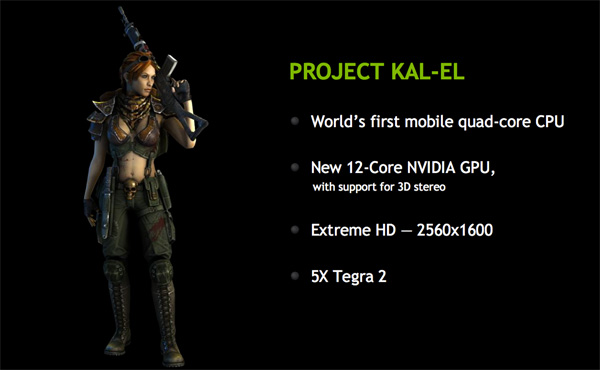
NVIDIA just dropped a bombshell. Not only is its third generation Tegra architecture, codenamed Kal-El, back from the fab but it's up and running Android after only 12 days. Kal-El will begin sampling soon and NVIDIA claims you'll be able to buy tablets based on it in August of this year, with smartphones following before the end of the year.
The SoC race just got a lot hotter, read on to find out what we know about Project Kal-El.
More...
-
02-16-11, 04:21 AM #330
Anandtech: Samsung's Tegra 2 Superphone: The GT-I9103
On Day 0 of this year's Mobile World Congress Samsung and NVIDIA announced that the new Galaxy Tab 10.1 will come to market with NVIDIA's Tegra 2 (T20) SoC. At the same time, the two quietly announced they would be working on a new superphone together also based on Tegra 2. At Samsung's press conference however all we saw was the Galaxy Tab 10.1 and the Galaxy S II, the latter using Samsung's own Exynos SoC.
So what happened to the NVIDIA based smartphone and why would Samsung bother with using Tegra if it already had an Exynos based smartphone? To understand why we need to look at the Galaxy S. At its MWC press conference Samsung mentioned that it sold 10 million Galaxy S phones in 2010. The Galaxy S II should sell at least as much, if not more, once it's officially introduced.
Exynos however is a brand new SoC, with a brand new GPU for Samsung. Meeting demand for the Galaxy S II in all markets across the world with an SoC that Samsung has never shipped is risky at best. If you saw our benchmarks yesterday you'll note that NVIDIA's Tegra 2 is a near equivalent in terms of CPU performance and notably better in GPU and Flash performance. In other words, Tegra 2 isn't a bad alternative.
Meet the GT-I9103:
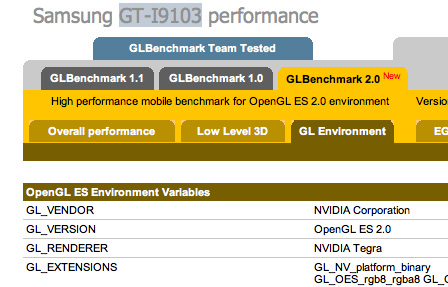
The GT-I9100 is the normal Exynos based Galaxy S II, the I9103 is the Tegra 2 edition. As one of our readers (thanks sarge78), Samsung lists its own dual-core Application Processor in the Galaxy S II as not being used in all regions. It's too early to tell if that means that we'll get Tegra 2 or Exynos depending on physical region.
I suspect Samsung didn't want to confuse users by announcing both a Tegra 2 and an Exynos based superphone at MWC. An unknown user managed to benchmark the GT-I903 at MWC and submitted the data to the GLBenchmark database. The GT-I9103's performance looks comparable to the Atrix 4G, meaning it's going to deliver the same experience we've seen in our Optimus 2X and Atrix 4G articles.
More...
Thread Information
Users Browsing this Thread
There are currently 15 users browsing this thread. (0 members and 15 guests)




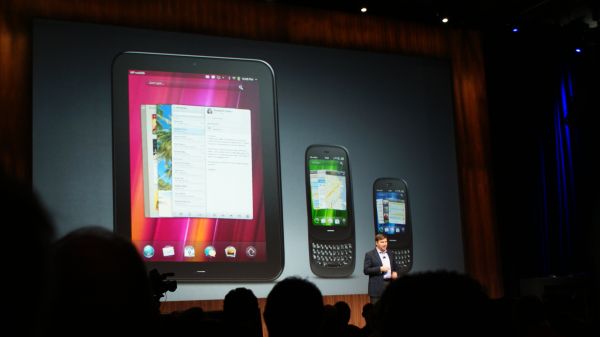

 Quote
Quote
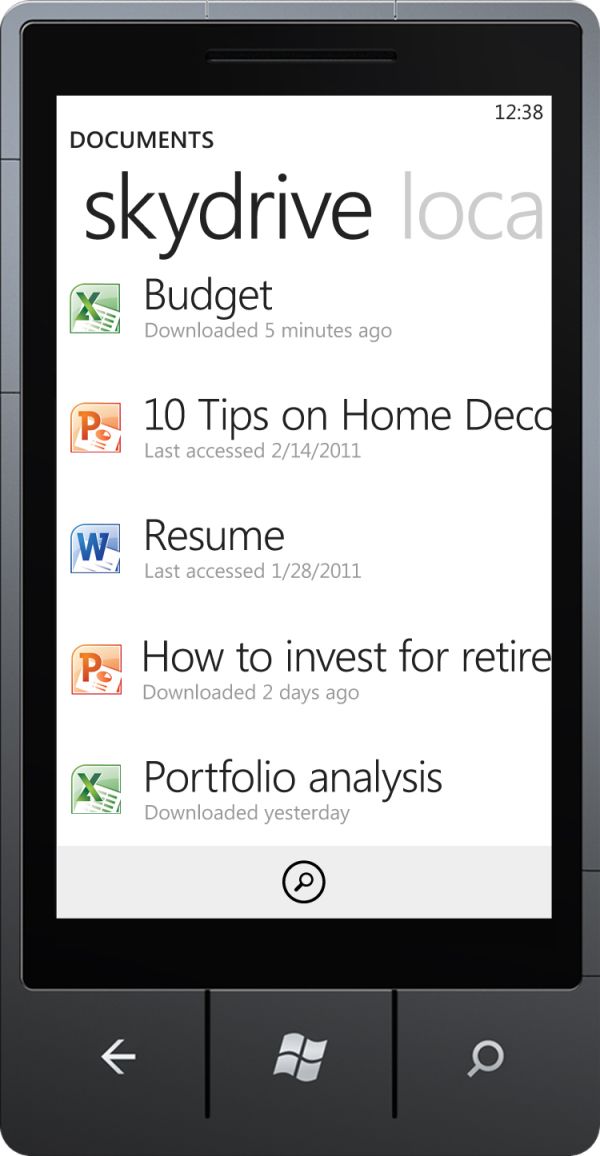
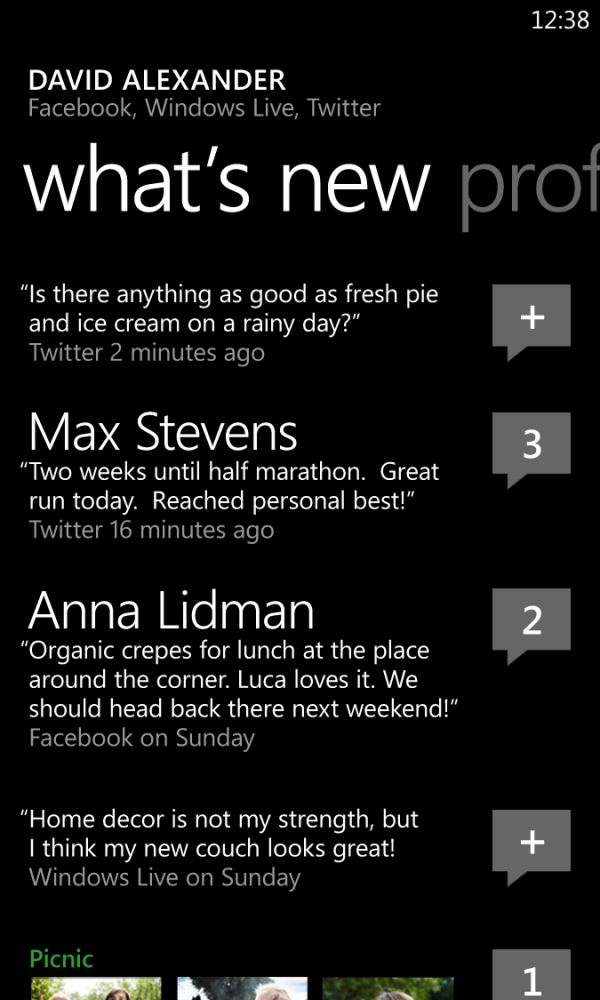


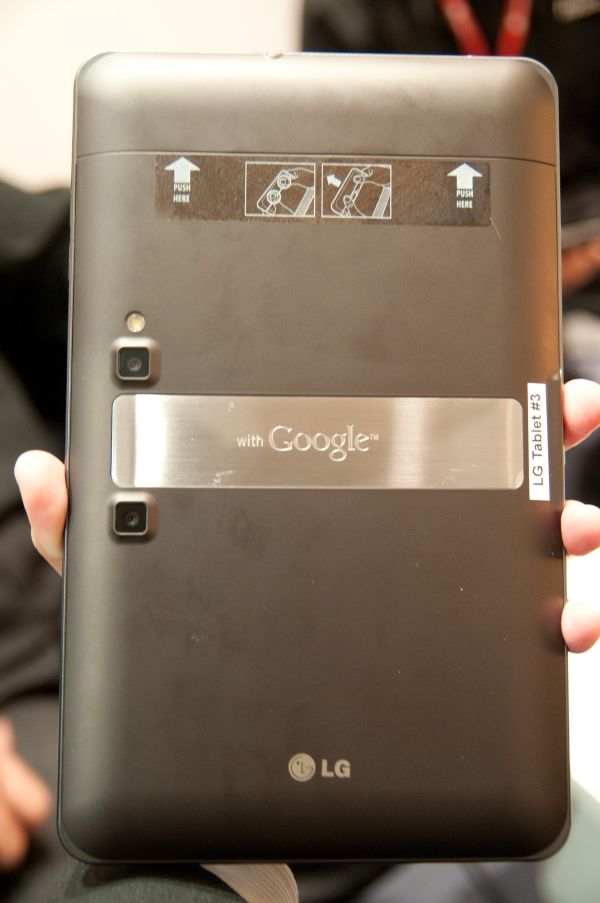
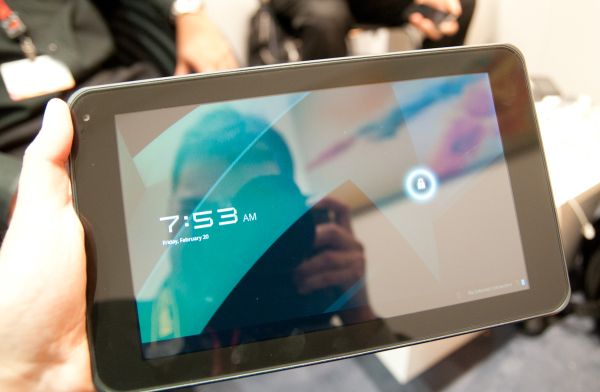
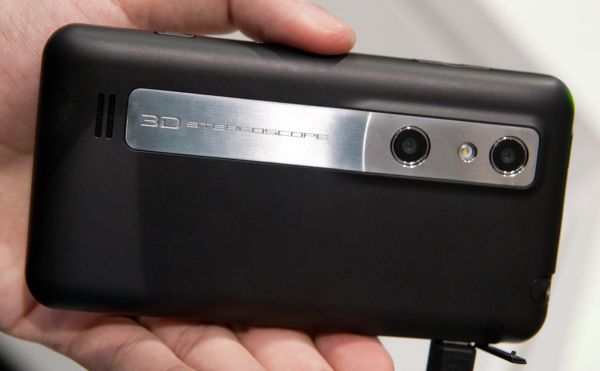

















Bookmarks